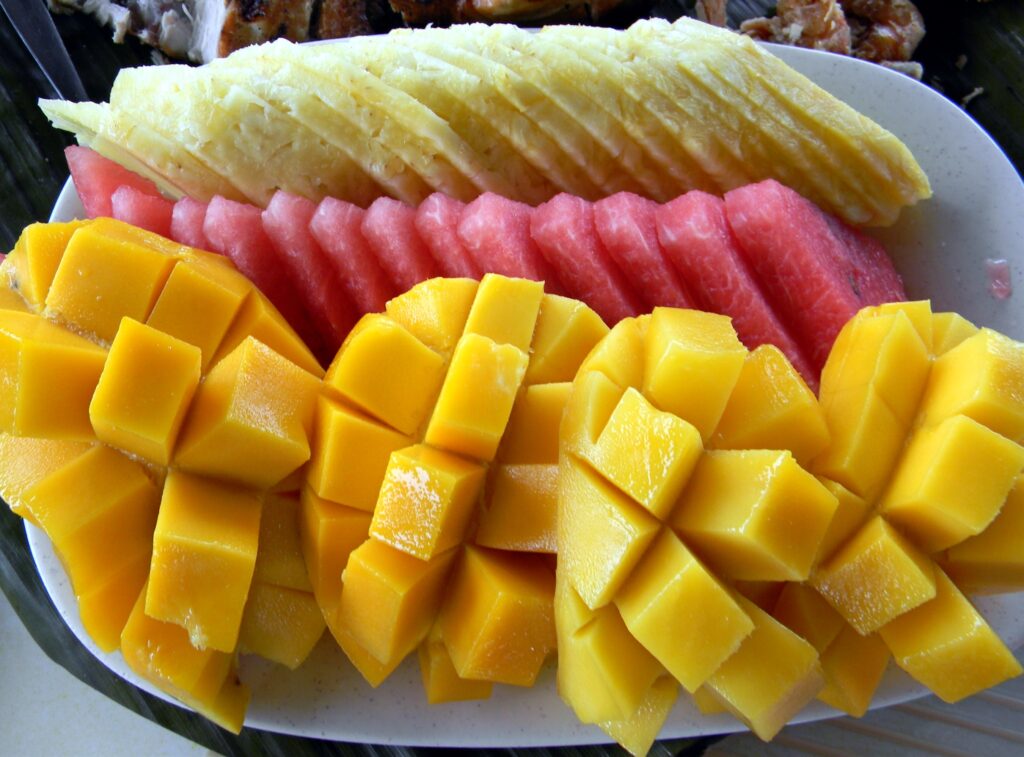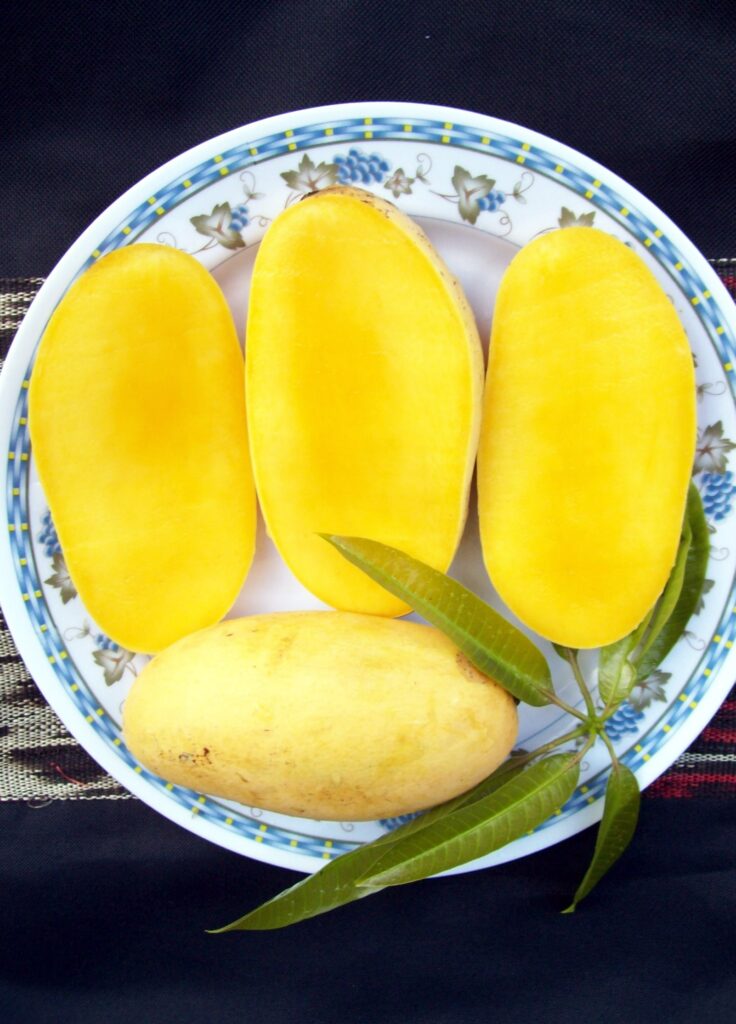Text and Photos by Henrylito D. Tacio
Indeed, there is a sure market for mangoes, according to the Agribusiness and Marketing Assistance Division (AMAD) in Davao Region. Around 93 percent of the country’s mango supply is consumed locally. Of this proportion, it is estimated that 75 percent are eaten as fresh fruit, and 25 percent are processed into various product forms.
Next to banana and pineapple, mango is the third most important fruit crop of the country based on export volume and value. The country’s export variety, the “Carabao mango,” is one of the best varieties in the world. In fact, the Guinness Book of World Records listed the said variety as the sweetest mango in the world.
“With the world market demand for mango rapidly growing, several measures must be done to improve harvesting and postharvest handling to prime up the Philippine mango industry,” observed the Laguna-based Philippine Council for Agriculture, Aquatic, and Natural Resources Research and Development (PCAARRD). “Because mango is highly perishable, prone to mechanical damage, and susceptible to postharvest diseases, its quality must be ensured right along the supply chain.”
The PCAARRD, a line agency of the Department of Science and Technology (DOST), has come up with “Mango Harvesting and Postharvest Handling,” a booklet that provides information in proper harvesting post-harvesting handling and disease control, and packaging of mango.
Among the materials needed for harvesting is a bamboo ladder, picking pole, rope, newsprint, and “kaing.” “Harvesting should be done at the proper stage of maturity,” the 12-page booklet states. “This determines the keeping and eating quality of the fruits.”

Mango for eating 
Factors affecting the rate of fruit maturity include climate, the elevation of the area, and the physiological status of the three at the time of flower induction. “The number of days from potassium nitrate spraying is commonly used to determine fruit maturity for harvesting,” said another PCAARRD publication, Mango Production Manual.
Generally, fruits can be harvested 105-130 days after flower induction. The fruit matures faster during the hot, dry months. However, maturity takes more than 115 days during colder months.
The following are the maturity indices used as a guide in harvesting: flat shoulder at the stem end (pedicel), full cheeks, presence of white powdery deposits on the peel (called “bloom”), creamy yellow pulp, and higher density as evidenced by the sinking of 80% (12 of 15 fruits) or more in a 1% salt solution (10 grams of salt dissolved in one liter of water).
Harvesting must not be done too early in the morning. “(Doing so) causes rapid flow of latex from the pedicel-end,” the manual informs. “Harvest the fruit when the leaves are dry from 9 am to 3 pm.”
For small trees, handpicking is done. For large and tall trees, the mango manual suggests this: “Tie one end of the rope to your body and the other end to the collecting basket (lined with paper on side and bottom). Climb up the tree. Hang the basket freely on one big branch. Untie the end of the rope from your body and tie it on another big branch nearby. Now you can start picking the fruits using a picking pole. Once full, transfer the fruits from the poles to the collecting basket. When full, lower the basket slowly to the ground for unloading by another person.”
When the fruits are already on the ground, they “are sorted according to their market quality and size,” the booklet says. “Sorted fruits are packed in plastic crates with newspaper lined in-between layers of fruits. Importing countries have different set of requirements and standards on exportable grade mangoes.”
The hot and humid conditions of the Philippines favor the development of mango diseases such as anthracnose and stem-end rot. To reduce the incidence or severity of these diseases, especially for mangoes harvested during the rainy season, the booklet recommends the harvested mango fruits to undergo hot water treatment (HWT).
“In HWT, the fruits are dipped in hot water (52º to 55ºC) for 10 minutes followed by hydrocooling in tap water for another 10 minutes,” the booklet instructs. “After hydrocooling, the fruits are air-dried (either inside or outside the crates) for about 30 minutes before packing.”
According to the mango manual, the benefits derived from HWT are the following: (1) when performed not later than two days after harvest, HWT reduces disease incidence and severity or at least delay the onset of the disease so that the fruits may have ripened and consumed long before the disease symptoms would have appeared; (2) HWT removes dirt, dust, latex stain, and chemical residues; and (3) the treatment directly benefits the retailers, consumers, and processors by reduction of losses and increase in quality.
The type of container to use depends on the intended market. “The best container for mangoes is the plastic crate,” the booklet says. “The plastic crates are durable, easy to handle and clean, and prevent injury during transport.”
Fruits intended for export to Japan and South Korea are packed in a different manner. The fruits, wrapped in thin paper, are packed pedicel-down in a cell-type fiberboard carton in a single layer with a net capacity of 5 kilograms.
For Hong Kong and China markets, cartons with a capacity of 12 kilograms are used. The box is divided down the middle with a vertical driver, and clean papers are used as liners in-between layers of fruits.
Mango fruits should be exposed to a low temperature to extend the marketable life. “At the recommended storage temperature of 12.5ºC, mangoes can be stored for two weeks, although ripening will set in towards the end of the second week,” the booklet says.
The storage life of Philippine mango fruits – also called “Carabao” mangoes – can be extended for 29 days when kept under controlled atmosphere (CA) conditions at 12.5ºC to 13ºC. “In this technique, the level of oxygen in the storage room is maintained at 5-6% while the carbon dioxide concentration is 4-5%. Mangoes are almost 50-70% yellow when taken out of CA storage and completion of ripening occurs when fruits are transferred at a temperature of 20ºC to 23ºC.”
In the Philippines, ripe mangoes are eaten fresh as a dessert or processed into dried mangoes, puree, juice, concentrate, shakes, and many more. When eaten green, they are a tasty treat for lovers of sour fruits as they are usually dipped in salt, fermented fish, or shrimp (bagoong). Green mangoes are also pressed into juice and shakes.
Mango is also used to make juices, both in ripe and unripe form. Pieces of fruit can be mashed and used in ice cream or blended with milk and ice to make thick milkshakes. In Thailand and other Southeast Asian countries, sweet glutinous rice is flavored with coconut then served with sliced mango on top as a dessert.
History records showed that mangoes originated from the Myanmar region, where it was known to have been cultivated 4,000 years ago. Buddhist monks took mango to Malaya and eastern Asia in the 5th century B.C. Later in the 18th century, Portuguese explorers would introduce mango in Brazil.
From there, mango cultivation would reach Florida, USA in 1833 and eventually in Africa and in other lowland tropical and sub-tropical areas. Today, there are about 83 mango-producing countries in the world.

